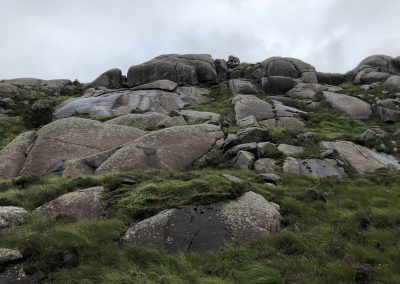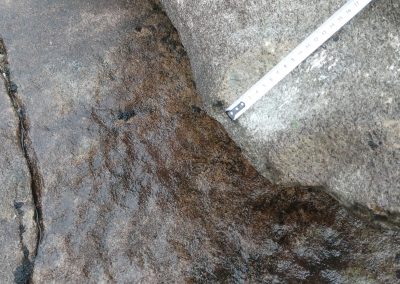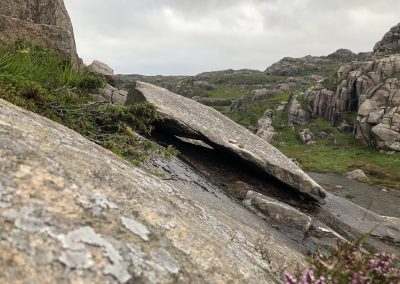The Singing Stone by Bjørndalsnipa
Type: Ringing stone
Local name: Klingaren, Syngaren, Syngjarsteidn
Locality
County: Rogaland
Municipality: Hå
Location: Ognaheia, between Ualand and Heresvela
The stone is located at 109 meters above sea level in the heath approximately 600 meters north-west of the bridge over the river Ogna near the abandoned farm Ualand. From the forest road that runs from Ualand and north towards Bjørndalen, there is a dense spruce forest that is difficult to get through; it is better to enter the heath west of this dense forest. The ringing stone is located about 1.5 km south of the hill Bjørndalsnipa – the highest point in the area (274 m.a.s.l.).
Description
This almost square stone slab of around 10 square meters lies on a smooth rock surface below a hill, slanting downwards in a northerly direction. It has contact with the solid rock merely in a few places, giving plenty of free air underneath. Tapering down from the innermost (top) part—which is 60–70 centimeters thick—it is only a few centimeters thick at the outer edges at the bottom and on the sides. There are visible wear marks at the lower corners. The most obvious cup mark (in the corner to the north) is rounded, with a diameter of 10 centimeters and depth of 3 centimeters. Just next to this cup mark, half of another equally large cup mark is visible. In this place, someone has knocked off a small piece of the stone. (See photo). Generally, the sound is deep and metallic, and the pitch varies depending on where you strike.
Cultural history and tradition
The stone has been called Syngaren, Syngjarsteidn or Klingaren, and has been known by the local population. In an article in Stavangeren from 1931, the sound from the stone is described as the sound of “a good village church bell”. The farmer Hans Ualand says that in quiet weather the sound was not only heard at the farm Ualand, but all the way to Øksnabø in Eigersund, over five kilometers away. Furthermore, the article describes the sound from the stone in poetic terms: “… there are probably many who over the course of time have listened to the church bell of the mountain while the shepherds in bygone days pounded it—late and early. No wonder there are depressions in the «Syngjarsteidn». Now it is very rare to hear the bell sounds from here. The ringers, those knocking, do not appear, the shepherds are gone, only now and then it happens that a lone hiker gets lost up there, but of course he cannot resist trying the bell … and the tones rise—up and into the mountain plateau—while those who meet the mountain are thrown back so that the whole valley is filled with the sound of bells. And again people stop and listen in silent wonder until the last tones die away and the silence of death once again reigns over the mountain plateau. …”
The stone is located not far from the old “dabbevegen” (walking track) between Ualand and Heresvela. There are several local place names in this area that are not registered on maps, for example Trodlanodland and Leidestjødnå, which are mentioned in the book Folkeminne frå Ognaheiå (Folklore from Ognaheia): “At Leidestjødnå (lakes) by the dabbevegen to Heresvela lies Trodlanodland where there is a 24 meter long cave in the mountain. Near the lakes lie the stone called Syngjaren or Klingaren.”
Sources: Folkeminne frå Ognaheiå. Eit dugnadsarbeid år 2000 (Folklore from Ognaheia), ed. Audun Øyri (p. 27); Morten Lindtjørn: «Ådalen og den innestengte ættegårds saga. Et bortglemt hovedvei-projekt i Sør-Rogaland. Den 70-årige fjellbonde, som la ut kr. 6000 til vei, men ennu må bruke kløvsalen» (Ådalen and the saga of the enclosed family home. A forgotten main road project in South Rogaland. The 70-year-old mountain peasant, who spent NOK. 6,000 for the road, but still have to use cargo saddle), Stavangeren 10 January 1931 (pp. 5–6); Egil Mong: “Klangfull stein og vid horisont” (Resonant rock and wide horizon. Jæren and Dalane from Bjørndalsnipa), Dalane tidene 18 February 2002 (pp. 1, 6–7).





